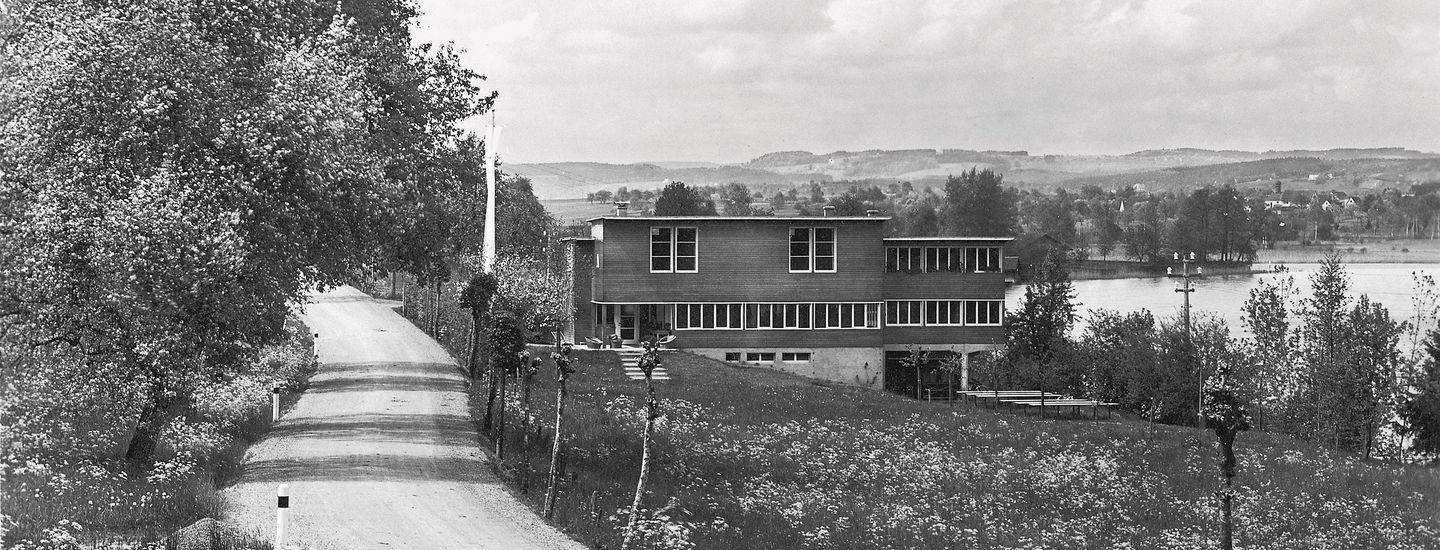
2000 to 2010
Repositioning and image adjustment
«Youth hostels are no longer just geared towards young hikers. The buildings in Zurich and Zermatt have recently been renovated and expanded. A comprehensive design concept defines the direction in which the Swiss Youth Hostels should develop – a balancing act between the romance of a bunk bed and economic competitiveness.»[1]
«The Swiss Youth Hostels. The most exclusive hotel chain in the world.» It’s image that counts.
The 75th anniversary in 1999 includes a host of advertising measures, ranging from media PR campaigns, posters at major Swiss railway stations, the sponsorship of mountain bike races for young talent and the SIGG anniversary bottle, which brings the association and its work to the forefront of everyone’s minds.
The development of tourism requirements can also be followed in the architecture of the youth hostels. Originally «close-to-natural accommodation with group camps» was transformed in the 2000s into hostels with a proportion of private rooms of a competitive standard, multifunctional communal areas and professionalised operating procedures.[2]
Back in 1997, the youth hostels develop a concept based on the «Energy 2000» campaign programme, which aims to save 10% of energy by the year 2000. Architect René Dobler, who was appointed new management board member of the Swiss Foundation for Social Tourism in mid-1999, drives the energy concept forward. From 2009, the Swiss Youth Hostels obtain 100% of their electricity from renewable hydropower. In addition, they reduce specific CO2 emissions for space heating by two thirds by 2022 compared to 2000.
The climate in turmoil
In 2003, a heatwave hits the European continent. It reaches its peak in the following two weeks after Swiss National Day. The «heatwave summer» is estimated to have claimed 975 lives. The youth hostels are also concerned and expect climate change to have an economic impact. Winter tourism accounts for a large proportion of the income from overnight stays. «We are noticing that the snow reliability of a destination is becoming increasingly important. When we look for new locations, this is what we pay particular attention to. Ski resorts in the Alpine foothills are almost out of the question,» Hans-Urs Häfeli from the Swiss Foundation for Social Tourism tells photovoltaic magazine Solarspar in early 2004. This means doing everything in our own interests to keep greenhouse gas emissions as low as possible so that the climate remains stable.[3]
Since 2008, the youth hostels have offered the option of paying a voluntary payment to offset the CO2 emissions generated during a stay. The concept of the «Ecological Footprint» is a Swiss-Canadian invention that tries to explain in simple terms how much natural resources are consumed in terms of area that would be necessary to produce these resources. Today, around 60% of guests offset their CO2 footprint every year. Continuing in collaboration with the myclimate foundation, the concept is extended to all tourism throughout Switzerland in 2018 through the «Cause We Care» climate protection contribution.
Expo.02 – a collective spectacle after a world-changing year
In 2001, Switzerland is shaken by a catastrophic autumn. In the wake of the terrorist attacks in the USA on 11 September, devastating events have also taken place at home. In Zug, an assassin shoots 14 people in the cantonal parliament, on 2 October Switzerland witnesses the Swissair grounding and on 24 October there is a fire in the Gotthard Road Tunnel. The federal self-image has been fundamentally affected. The opening of the national exhibition Expo 02, which will take place from 15 May to 20 October 2002 in the Three Lakes Region on the banks of the cities of Biel, Murten, Neuchâtel and Yverdon-les-Bains, gives the country a boost. Within six weeks, the Swiss Youth Hostels develop the «expo.sleeper» youth hostel, offering 240 beds at affordable prices at the «Arteplage» Neuchâtel. Young people and families, groups and individual travellers can sleep in four original sleeper coaches in 60 couchettes, each divided into six-compartments on wheels. Demand is high, as the price of CHF 30 per bed for group bookings of entire compartments offers an unparalleled discount. The youth hostels are in the same situation as many others during the preparatory phase of the Expo. Project after project is abandoned – only those within the scope of the organisation’s core competencies can be successfully implemented. A railway adventure with modern sanitary facilities and breakfast buffet included. And since the whole thing is sustainable, there is also the official Expo.02 «Flying Fish» eco label.[4]
[1] Christina Sonderegger in Werk, Bauen + Wohnen, Band 91 (2004), Heft 10, p. 50.
[2] Cf. Schweizer Jugendherbergen, Eine nachhaltige Architekturgeschichte, (Swiss Youth Hostels, A Sustainable Architectural History) 2015, Foreword, p. 3
[3] Cited from Solarspar-Zeitung No. 1, 2004, p. 3.
[4] Cf. Media Releases 1, 2 and 3 published by the Swiss Youth Hostels, 2002







Share this page